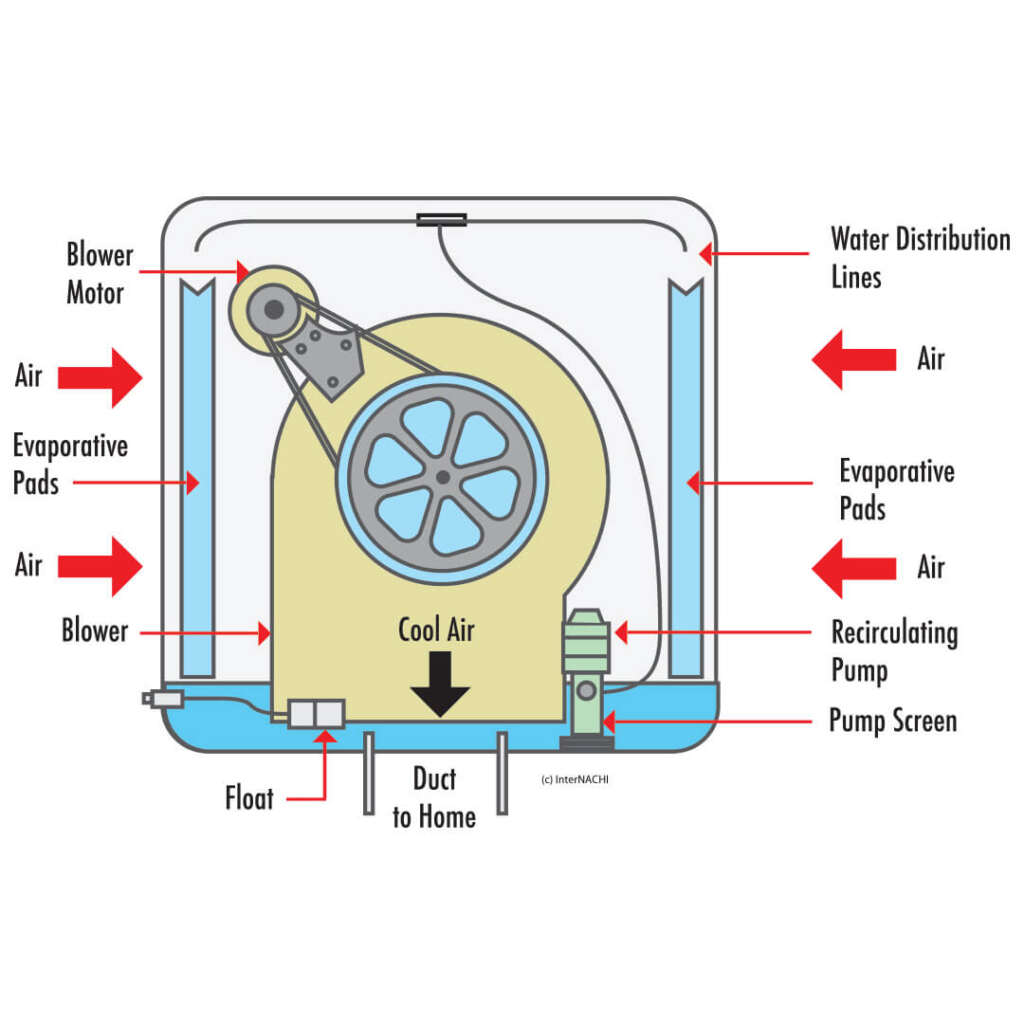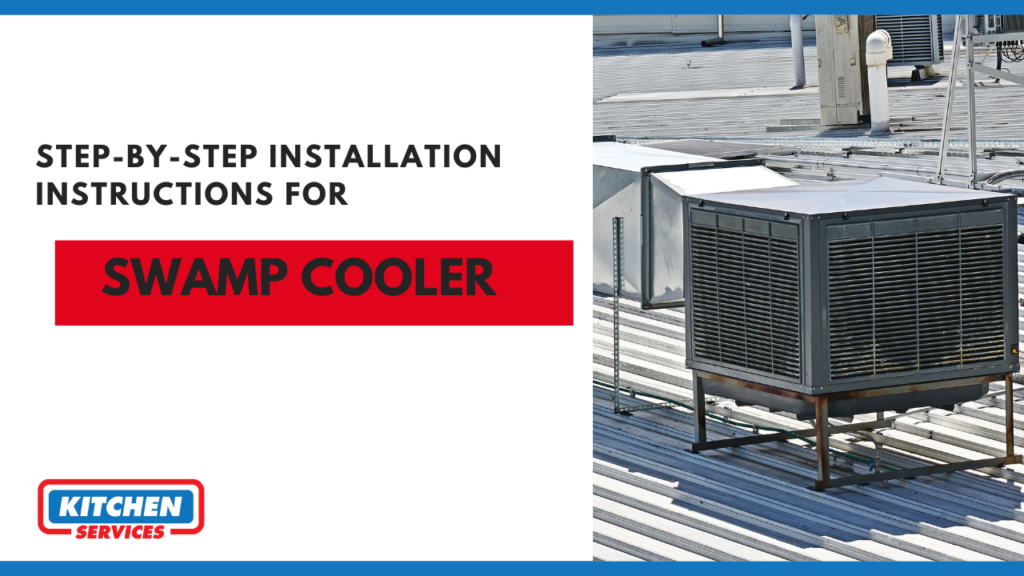Commonly swamp coolers can be found in those climates that are dry and hot. Swamp coolers actually function by a process that is commonly known as evaporative cooling and are thus recognized as evaporative air conditioners.
This is somehow the same as the human body works to eject heat through the sweating process. Usually, when humans sweat, they produce a layer of liquid on top of the surface of their skin. This process actually absorbs heat from your body. Then the heat in the air causes this liquid in the form of sweat to evaporate from your skin, causing your body to cool down. Same in this way, swamp coolers work, and they take in warm air from the environment outside and pass them through evaporative cooler pads. As they are wet, so they act to cool by the air passing through. This cooled air is then turned into the interior of the building all through a vent. This process is done through the use of a blower motor.
Parts of a Swamp Cooler

Evaporative Pads
Evaporative pads are the interior of the swamp cooler. They are actually the wet pads that are usually used to cool down the flow of air. If these pads are dry, then the cooler will not perform accurately.
Blower or the Blower Motor
The motor in the swamp cooler is normally used to stimulate the blower. As a reaction, it pulls air into the relevant tube, and then it helps in cooling the home or the area that has to be cooled. The motor tends to be between ⅓ and 1 horsepower and uses 115 to 120 volts of energy.
Float in Swamp Cooler
Float in swamp cooler is actually located very close to the base of the swamp cooler. It is basically used to control the water level that is already there within the cooler. When the water level rises, the float level rises as well. When the water reaches a specific level, the float is used to shut off the water supply valve. The float is used to inhibit the swamp cooler from bursting and make it sure that it works accurately.
Pump
Same as the float the pump is also usually located at the base of the swamp cooler. It helps in forcing the water through all the supply lines, guaranteeing that the evaporative pads stay wet. If these pads are not wet as required, you will be more likely to feel the need to change and replace the pump in time. If the pump is still working but the pads are not appropriately wet, you will probably have to increase the pump size.
Water Supply Valve
The water supply valve is the main component that will let the water enter the swamp cooler, which then allows it to perform its function in the best possible way properly. This generally comes from the inside of your home and is used to connect the cooler to the plumbing system. This valve is connected to the cooler with the help of a copper tube. This is crucial to the function of the swamp cooler.
Wire Connection Box
The wire connection box is the reason why the power supply can enter the swamp cooler. It is usually connected to a wired connection block, and it uses leads to connect the power supply to the other components of the cooler.
Drainage and Overflow Tube
The drain is a tube that is located near the base of the cooler and can be removed to drain water out entirely. In addition, if the water level starts to rise too high then the water will drain out through the center of the tube. This can spill onto the ground, making it easier to notice if there are any issues in the swamp cooler.
V-belt
V-belt is a drive belt that can help to move the lifters inside of the swamp cooler. The main issue is that these belts can stretch, loosen, and wear out with the passing of time. It must also be correctly associated inside the cooler if it is to work. You must always keep an eye on the condition and tighten your v-belt accordingly. V-belts come in various sizes, and you should take care to choose the correct size belt. They are very strong and non-slippery.
Also Read: What is a Swamp Cooler?
How to install a Swamp cooler?
Step 1: Install the Support Bracket
You may have seen somewhere that most of the weight of a swamp cooler extends outside the house, so that is exactly where the support bracket should be used. It generally comes with a cooler, so you just have to follow the company’s instructions for installing it in a proper manner. It will indicate how far below the window sill it needs to be installed. All you have to do is to level the bracket with a 4-foot level before driving the buckles into the siding with a drill or socket wrench.
Step 2: Open the Window to Install the Unit
Most of the swamp coolers are designed in such a way that they can be installed in windows that usually opens vertically. In order to install a swamp cooler, you need to open the window all the way and with a help of a labor, position this swamp cooler so it is resting on the bracket and window sill and the indoor portion is inside the room.
Step 3: Install the Side Fins
After the previous step, you will have to slide the edge of one of the fins that are supplied with the unit into the track on the side of the cooler and open it until the other end contacts with the window frame. All you have to do is to secure it with two 1 1/4-inch screws and then seal both of the ends of the fins with a silicone seal. Repeat with the fin that goes on the other side. After that close the window and seal the gap between the window and the top of the cooler with caulk.
Step 4: Connect the Water, plug in the Unit and Test It
After that, you will have to connect the water supply using the method you have chosen and then turn on the water and let the tank fill. A float valve in the reservoir should turn off the water when the tank is full. After that plug the unit into a 120-volt GFCI outlet and then turn it on and make sure it is running smoothly.
Kitchen Services is a leading HVAC service provider in Los Angeles, Santa Monica, and around. Our team makes sure the perfect swamp cooler installation and integration into your kitchen for adequate performance and energy efficiency.
How to Install Swamp Cooler in Window?
o install a swamp cooler in a window, follow these steps:
- Prepare the Window: Open the window wide enough to fit the swamp cooler. Remove or secure any screens if necessary.
- Assemble the Cooler: If your swamp cooler isn’t pre-assembled, follow the manufacturer’s instructions to assemble it.
- Position the Cooler: Lift the swamp cooler and place it on the window sill, ensuring that the front (air outlet) faces inside the room and the back (air intake) is outside. The cooler should be centered in the window.
- Secure the Cooler: Lower the window sash until it rests on top of the cooler, securing it in place. If needed, use brackets or screws provided with the cooler to attach it to the window frame for added stability.
- Seal the Gaps: Use weather stripping, foam, or other insulating materials to seal any gaps around the cooler. This prevents warm air from entering and keeps cool air inside.
- Connect the Water Supply: Attach a water supply line to the cooler’s inlet valve. Ensure the connection is secure to prevent leaks. If your cooler has a built-in water reservoir, fill it with water.
- Plug in the Cooler: Connect the swamp cooler to a power source. If the cooler is hardwired, follow the manufacturer’s wiring instructions.
- Test the Cooler: Turn on the swamp cooler, ensuring that it operates correctly. Adjust the settings and check that water flows properly over the pads and that the fan blows cool air into the room.
- Maintain the Cooler: Regularly check the water level, clean the pads, and ensure the cooler is functioning efficiently.
Ensure that the window can support the weight of the cooler and take precautions to prevent it from falling.
How to wire a Swamp Cooler?
Wiring a swamp cooler involves connecting the motor, pump, and thermostat to a power source. Here’s a general instruction:
- Turn Off Power: Ensure the power is off at the breaker to avoid electrical hazards.
- Access the Electrical Box: Open the electrical box on the swamp cooler, usually located near the motor.
- Connect the Wires:
- Motor Wires: Connect the motor wires to the corresponding terminals in the electrical box. Typically, black is hot, white is neutral, and green is ground.
- Pump Wires: Connect the pump wires similarly, ensuring they match the motor connections (black to black, white to white, green to ground).
- Thermostat Wires: If using a thermostat, connect its wires to the motor and pump terminals according to the thermostat’s wiring diagram.
- Secure Connections: Use wire nuts or connectors to secure all connections, ensuring there are no loose or exposed wires.
- Grounding: Ensure all components are properly grounded to prevent electrical shocks.
- Test the System: Once wired, turn the power back on and test the system. Make sure the motor, pump, and thermostat function correctly.
- Close the Electrical Box: After confirming everything works, close the electrical box securely.
Also Read: Air Conditioner Installation Guide
Common FAQs
How does a DIY swamp cooler work?
Some DIY swamp coolers are also called swamp boxes or evaporative coolers. This swamp cooler moves the warmer air through evaporative cooler pads that help in producing the cool air. By means of a blower motor through a vent, this cooler air can then be blown into a room so it can feel less warm than before.
Can you install a swamp cooler yourself?
This may sound like a tough thing to do, but in reality, it is very easy enough to install a swamp cooler all by yourself. You will still need a helper though, and you have to make sure that you have purchased the right-sized swamp cooler that will fulfill all your needs. Usually, the swamp cooler is seen installed on a roof.
Do swamp cooler actually cool?
As we know that the air conditioners draw moisture out of the air, swamp coolers actually cool with the opposite effect by adding so it adds humidity to the air that it blows out. The fan also constantly circulates air, so it creates a slight breeze as well, which will help make your body feel cooler.
How to hook up swamp cooler?
To hook up a swamp cooler, follow these steps:
- Choose a Location: Place the cooler where it can draw in fresh air, typically near a window or vent.
- Install Water Line: Connect the cooler to a water source using a hose or copper tubing. Attach the line to the water inlet valve on the cooler.
- Mount the Cooler: Secure the cooler in place, either on a window or roof, ensuring it’s level.
- Connect the Electrical Supply: Plug the cooler into a power outlet or connect it to your home’s electrical system if hardwiring is required.
- Install the Drain Line: Attach a drain hose to the cooler’s overflow drain to manage excess water.
- Check and Fill the Water Reservoir: Ensure the water reservoir is filled and the float valve is functioning correctly.
- Turn on the Cooler: Start the cooler, adjusting the fan speed and water flow to your desired settings. Make sure the pads are fully saturated with water before operating the fan.

